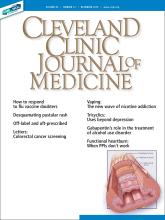IN REPLY: We thank the readers for their interest in our paper.
Drs. Goldstein, Mascitelli, and Rauf point out the concerning epidemiologic increase in the incidence of colorectal cancer (CRC) among individuals under the age of 50 and suggest folate as a potential cause.1
The underlying cause of the rise in incidence is unknown, and many environmental and lifestyle risk factors have been proposed.2–4 Black men have historically had and continue to have the highest incidence of and stage-adjusted mortality from CRC, but the rise of CRC in the young is a phenomenon in whites.1 Furthermore, these cancers are left-sided. Other known and proposed risk factors associated with this phenomenon include dietary and lifestyle factors such as alcohol consumption, smoking, obesity, and consumption of processed and red meat.5–7
The cohort effect of rising colon and rectal cancer incidence in younger individuals is likely due to changes in the microbiome. Antibiotic exposure is widespread and has been conjectured as a cause, as has folate supplementation, which began in the United States in 1998. Folic acid has been shown to be associated with both protective and harmful effects on colorectal neoplasia.8,9 While Goldstein et al recommend CRC screening starting at an early age in countries with folate supplementation, countries without folate supplementation have also noted a rise in early-onset CRC. For example, in Azerbaijan, the mean age at diagnosis of CRC in 546 individuals was 55.2 ± 11.5, and 23% had an age lower than 40 years. Nearly 60% presented at an advanced stage, and the majority of lesions were in the rectum.10
The impact of the confounding variables and risk factors resulting in the epidemiologic shift in young patients with CRC, along with the biology of the cancers, should be teased out. Once these are known, population screening guidelines can be adjusted. Until then, practitioners should personalize recommendations based on individual risk factors and promptly investigate colonic symptoms, no matter the age of the patient.
We also thank Drs. Joseph Weiss, Nancy Cetel, and Danielle Weiss for their thoughtful analysis of our article. Our intent was to highlight 2 of the most utilized options available for CRC screening and surveillance in the United States. As we pointed out, the choice of test depends on patient preference, family history, and the likelihood of compliance. The goal of any screening program is outreach and adherence, which is optimized when patients are offered a choice of tests.11–13 Table 1 from our article shows the options available.14
When discussing these options with patients, several factors should be taken into consideration. It is important that patients have an understanding of how tests are performed: stool-based vs imaging, bowel prep vs no prep, and frequency of testing.15 Any screening test short of colonoscopy that is positive leads to colonoscopy. Also, programmatic noncolonoscopic screening tests require a system of patient navigation for both positive and negative results. An individual may be more likely to complete 1 test such as screening colonoscopy every 10 years vs another test annually.
A common misconception about computed tomography colonography is that it is similar to computed tomography of the abdomen with a focus on the colon. Individuals may still have to undergo a bowel preparation and dietary restrictions before the procedure. Furthermore, a rectal catheter is used to insufflate and distend the colon prior to capturing images, which many patients find uncomfortable.16 Finally, the incidental discovery of extracolonic lesions may result in unnecessary testing.17
The sensitivity and specificity of each test and operator variability in accuracy and quality should also be highlighted. For example, the sensitivity of a one-time fecal immunochemical test to detect an advanced adenoma may be as low as 25%.18 All testing modalities are diagnostic, but only colonoscopy is therapeutic.
We agree that clinicians who perform CRC screening have an armamentarium of tests to offer, and the advantages and disadvantages of each should be carefully considered and individualized.
- © 2019 The Cleveland Clinic Foundation. All Rights Reserved.






